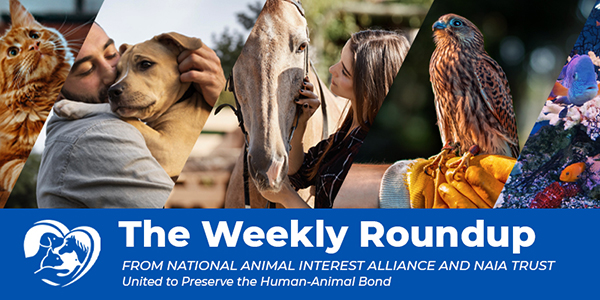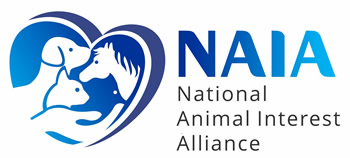
Inside This Issue:
- Rescue Dogs Still Being Flown into the United States from Rabies Endemic Countries
- Oregon Zoo-Hatched California Condor Celebrates His 20th Birthday in the Wild
- An Emotional Support Goose and the Human-Animal Bond
- AI Is Decoding the Languages of Animals
- Roaming Dogs Kill 29 FFA Show Animals in Florida
Rescue Dogs Still Being Flown into the United States from Rabies Endemic Countries

Street dogs as a whole are not helped by "rescue" importation efforts. Spay/neuter and vaccination programs at the source can help immensely, though.
A rescue organization is raising $750,000 so it can fly 200 dogs and 100 cats from Afghanistan into the United States. This is roughly $2,500 per animal, all of them flying in from a country where the threat of rabid mammals (especially dogs) is common enough to warrant an ominous CDC warning.
Now, we’ve explained ad nauseam why we view this type of importation not as a beautiful, photo-op worthy expression of man’s love for animals, but rather a half-baked and often cynical nightmare for public health and common sense. So, we won’t expound on that here. But if you need a refresher or are simply tired of hearing about it from us, we’ve linked to a fantastic recent summary of this issue from Animals 24-7.
What really strikes us this time are the priorities. Because even if there were absolutely zero public health and safety issues tied to rescue importation, what the heck are you doing bringing more rescue dogs in to the country right now? Of course, this type of importation has always been an ego-driven, cost-ineffective practice, more about good feels and fundraising than problem solving. But it’s 2024, folks. You can’t open an animal news feed today without stumbling across at least a dozen shelters and rescues begging for help with overcrowding. We have rescues and shelters laboriously reworking their adoption protocols and strategies in the hopes of getting just a few more dogs out the door. And rescues are regularly holding events where they literally give dogs away for free. Yet there are still organizations (including big ones, like HSUS) that feel “rescue” importation is a great use of resources when it comes to helping animals. Come on! If we’re truly worried about animal welfare, how many Afghan dogs and cats could be spayed/neutered and vaccinated with $750k? And what about US shelters? Just think about how far that could go toward relieving animal care, feeding, and staffing.
Telling others how they should be spending their money is, admittedly, a bit distasteful. At the end of the day, people and organizations are free, within the confines of the law, to spend their funds however they wish. And it’s easy to understand the appeal of rescue importation. It just “feels” heroic – like you’re really making a difference! – while fundraising for domestic shelter dogs (many of them larger and/or pit bull types) is less glamorous and more difficult. That said, there is nothing wrong with pointing out harmful and ineffective practices, and we hope that people who choose to adopt and donate make informed decisions, and prioritize local animals – where they can best make a difference for animals and their communities.
11 rescue dogs from Afghanistan on their way to Maine
Resources
★ It’s Now or Never: Stop Dog Trafficking Now!
★ CDC Travel Health Notice: Afghanistan
★ New rabies prevention rules for “rescue” puppy imports; HSUS squawks
★ Free dog adoptions at DC’s Humane Rescue Alliance to celebrate Valentine’s Day
Oregon Zoo-Hatched California Condor Celebrates His 20th Birthday in the Wild

What a smile!
The release of animals into their natural habitat takes the cooperation of animal care staff, federal and state governments, researchers, and conservationists. It takes a lot of hard work, and the Oregon Zoo is rightfully beaming with pride as the very first chick to hatch from their condor conservation center turns 20 years old this month. The male California condor, named Kun-Wac-Shun, hatched in 2004 and was released in 2005. He has been living in the wild at California's Pinnacles National Park where he has sired 5 chicks with his life mate, Tiny.
While Kun-Wac-Shun is a success story, it hasn’t all been a walk in the park. Like many condors, he has suffered from elevated levels of lead in his body and has required treatment for lead poisoning several times over the last two decades. Lead poisoning is also responsible for the death of his first life mate and first wild born chick. The Oregon Zoo is working with hunters and other conservationists to address this hazard and promote non-lead bullets. But overall, the future is promising. The California condor population now boasts roughly 500 wild birds and is growing!
20 years on, the first Oregon Zoo-raised condor is flying high at a national park in Central California
Resources
★ USFWS: California Condor Recovery Program
★ Non-lead hunting education program
An Emotional Support Goose and the Human-Animal Bond

Friend or fowl?
When you read headlines about an Iowa woman’s battle to keep her emotional support goose, it might be hard to keep from snickering. If you do snicker, that’s understandable. This is a goose we’re talking about, after all. And we’ve all probably had at least one experience with highly suspect “emotional support animals.” Furthermore, her city’s code is clear: you cannot keep geese as pets. So what’s she trying to pull here?
Pretty silly, right? Maybe. But the woman’s case, whether you feel it is legit or just another example of self-serving boundary pushing, brings up a lot of truths about the human-animal bond that are worth examining.
For one, she says her pet goose, Blue, is a great friend – the “light of her day,” in fact. Second, she says his presence has helped her navigate an exhaustive list of mental health issues, including suicidal thoughts. On top of that, she gives at least partial credit to Blue for maintaining her sobriety. Finally, she has said that if the city council won’t let her keep Blue, she won’t get rid of the goose – she’ll move.
This is an individual’s story, and as always, our own mileage with pets may vary (perhaps you’ve owned a pet that damaged your mental health). But there are a lot of general truths within: pets definitely light up our lives, and our animal companions’ ability to boost mental health is well known. Pets also offer unconditional love… while at the same time demanding the type of responsibility and daily routines from their owners that foster feelings of accountability and self-worth. Additionally (and less studied than anecdotal), many people in recovery have talked about sticking with the program not just for themselves, but because they have taken the responsibility of caring for their pets to heart. Finally, people moving for the sake of their pets isn’t uncommon, either. In one recent survey, 2/3 of respondents said they would be willing to move for the sake of their pets. In another survey, this one of Gen-Z’ers, respondents said they would be more likely to move for the sake of their pets than their partners.
So snicker all you want about emotional support geese… but no matter how this story ends, you can’t deny that the woman at the center of it all brings up several valid and relatable points.
Iowa woman battling city over emotional support goose: 'He's the light of my day'
Resources
★ Consumers Are Moving for Their Pets
★ Gen Z would prioritize pets over partners and kids if buying a home
AI Is Decoding the Languages of Animals
Sperm whales are huge, deep-diving cetaceans that enjoy things like hunting giant squid and creating some of the loudest sounds on the planet. When we say “loud” we are talking 230 dB, which makes sperm whales the loudest animal on earth. 230 is a lot. For reference, smaller caliber gunshots are around 140 dB, and we start running the risk of ruptured eardrums around 150 dB.
Sperm whale clicks have been recorded by highly sensitive instruments such as the ANTARES deep ocean telescope. Those recordings have offered insight into their communication and social structures. Researchers have found that with the use of AI, these collections of clicks, called codas, can be organized into common groups based on patterns. According to their paper, “Contextual and combinatorial structure in sperm whale vocalizations,” researchers have been able to categorize the codas into not only individual specific signatures, but a whole series of repeated patterns that they have dubbed a phonetic alphabet for whales. Using the rules for human speech, combined codas can form whale words and sentences.
This fascinating work is obtainable because of the power of AI which can parse through the recordings and find natural patterns in a way that regular computing cannot. In the future, the technology will no doubt be used to analyze other talkative creatures like bats and birds.
Sperm whale speech — with ‘alphabet’ — is decoded. What other animals can AI translate?
Resources
★ Contextual and combinatorial structure in sperm whale vocalisations
★ Sperm Whales Are Loud Enough to Burst Your Eardrums
Roaming Dogs Kill 29 FFA Show Animals in Florida

They didn't stand a chance.
We conclude this week’s roundup with a horror story out of Polk County, Florida, where three dogs dug their way under a fence, massacring 29 rabbits and chickens – and dashing the hopes of several FFA students.
The students were helping to raise and breed the animals and had planned on eventually showing them. Of course, the kids can start raising new chickens, but alas, any “replacement poultry” they receive won’t be old enough to show in time, so that’s at least one aspect of the program they will miss out on.
Many of the students come from city backgrounds and this was their first hands-on experience with animal agriculture. Hopefully it isn’t their last, because what a nasty experience – and painful life lesson – this turned out to be!
After providing a pitch-perfect example of why so many communities have enacted anti-running/roaming-at-large ordinances for their dogs, the livestock-massacring dogs’ owners have been cited (this also serves as an example of why timely and fair enforcement of such ordinances is vital). And while it won’t bring back any dead chickens and rabbits or help students compete in upcoming fairs, the school will be getting sturdier fences and housing to protect their animals from future predatory incursions.
‘Like a massacre’: Dog attack kills 29 show animals at Bok Academy North, FFA advisor says
Resources
★ Loose dog attacks, kills another dog in Reedsburg
★ Why Dogs Shouldn’t Be Allowed to Roam Free
Also in the News...
★ Groups protest Austin Animal Center, say leaders aren’t fixing changes needed (Rescues & Shelters; Overcrowding & Euthanasia; Infighting)
★ Greenwich Bans Traveling Acts From Using Specific Wild Animals In Town (More AR Bills Banning Things That Aren't Even Happening)
★ This video of a giraffe interacting with the vet has captured a million hearts online (Really Large Animal Vets; Rehab; Cute Videos)
★ 19-year-old accused of killing Petland animals charged with animal cruelty (Crime & Cruelty; Caught on Camera)
★ Four men indicted attempting to smuggle exotic birds from Puerto Rico to the Dominican Republic (Crime & Trafficking; Endangered Species)
★ Humans Are Driving a New Kind of Evolution in Animals (The Anthropogenic Evolution Is Upon Us; Architecture, Industry, and Pollution)
★ Here Are The Funniest Animal Photos Of Last Year And They Are Hilarious (Goofy Lists & Photos; "Hilarious" Is a Stretch, But Some of These Are Great)
Click here to see what is happening legislatively


